
How to Use Lora Ra-01: Examples, Pinouts, and Specs
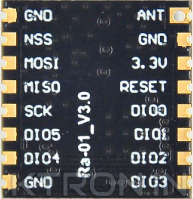
 Design with Lora Ra-01 in Cirkit Designer
Design with Lora Ra-01 in Cirkit DesignerIntroduction
The Lora Ra-01 is a long-range, low-power wireless communication module designed for IoT (Internet of Things) applications. Manufactured by Lora and based on the SX1278 chipset, this module leverages the LoRa (Long Range) protocol to enable robust communication over distances of several kilometers. Its low power consumption makes it ideal for battery-powered devices in remote or hard-to-reach locations.
Explore Projects Built with Lora Ra-01
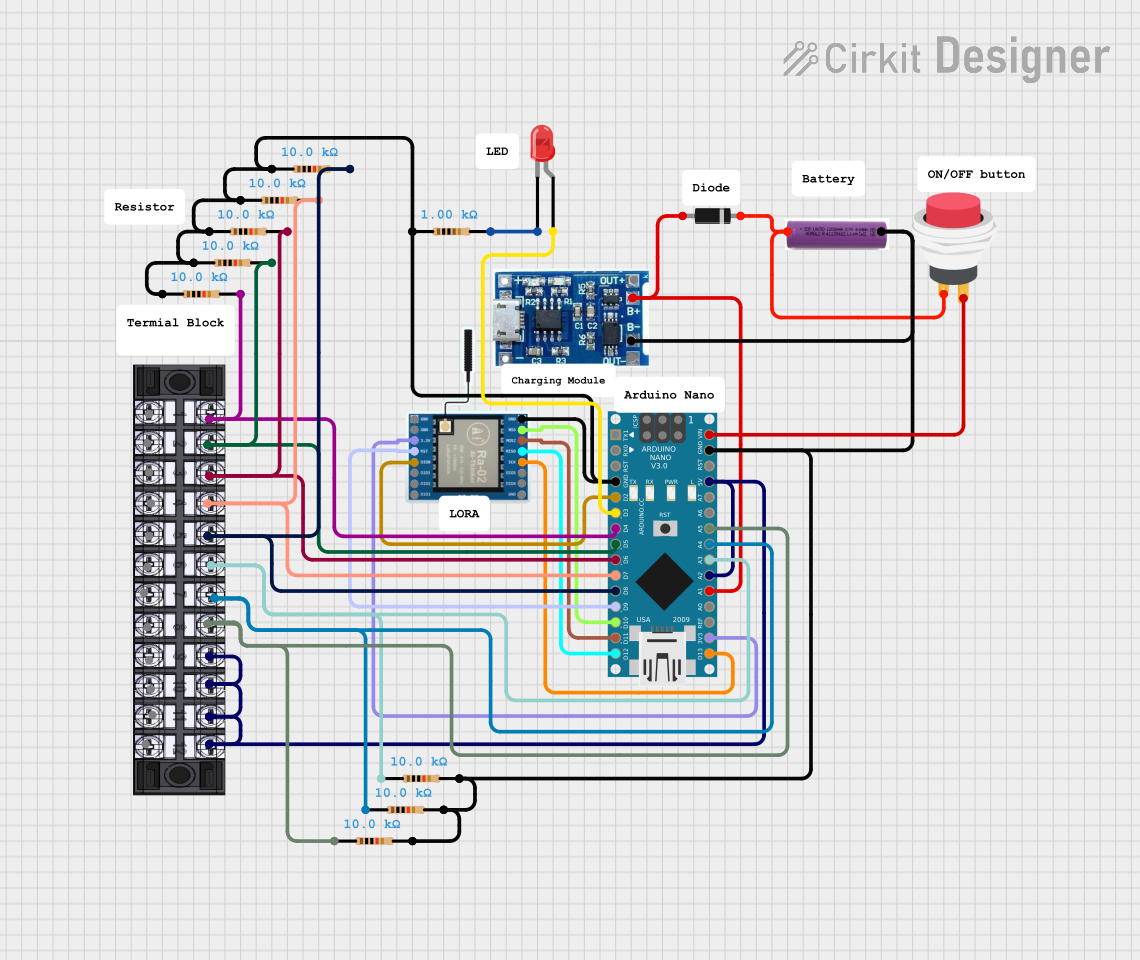
 Open Project in Cirkit Designer
Open Project in Cirkit Designer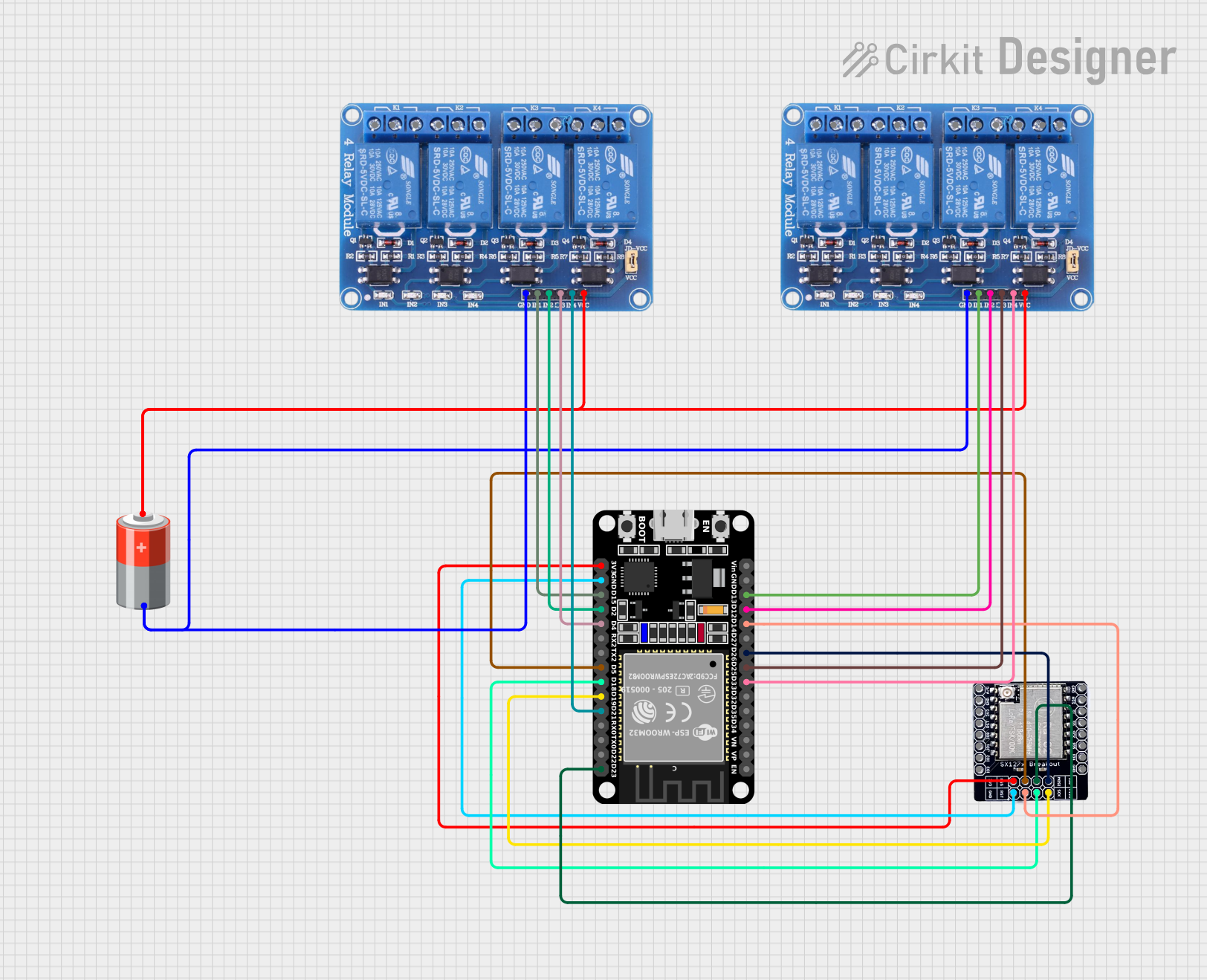
 Open Project in Cirkit Designer
Open Project in Cirkit Designer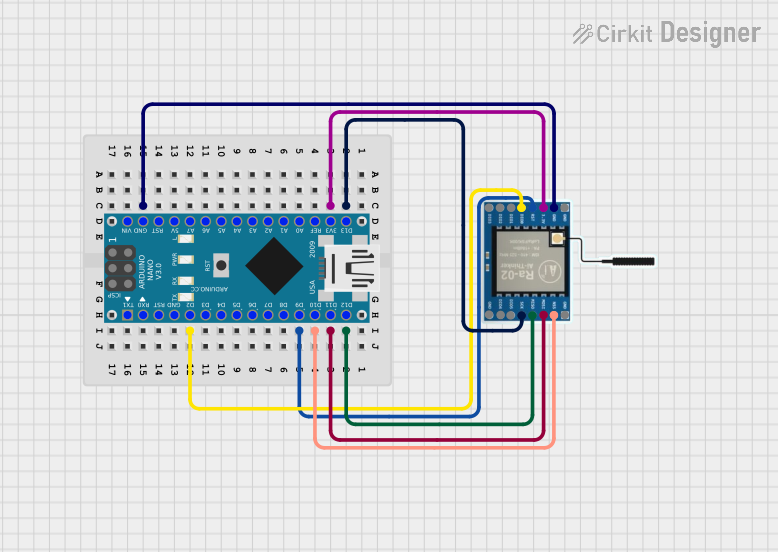
 Open Project in Cirkit Designer
Open Project in Cirkit Designer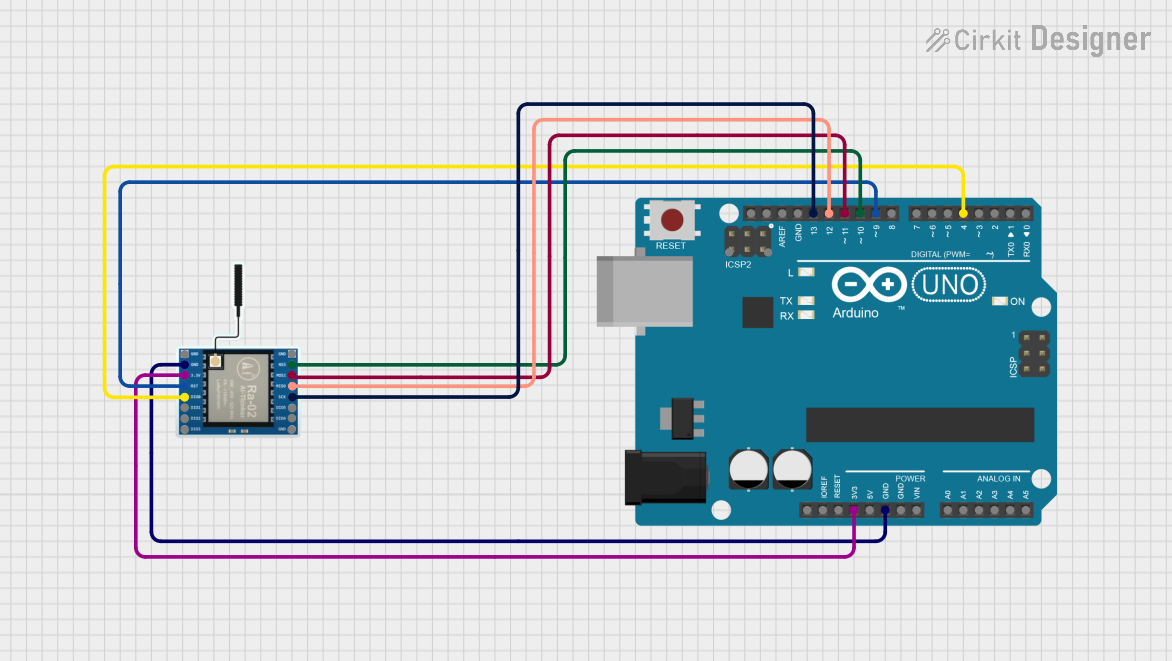
 Open Project in Cirkit Designer
Open Project in Cirkit DesignerExplore Projects Built with Lora Ra-01

 Open Project in Cirkit Designer
Open Project in Cirkit Designer
 Open Project in Cirkit Designer
Open Project in Cirkit Designer
 Open Project in Cirkit Designer
Open Project in Cirkit Designer
 Open Project in Cirkit Designer
Open Project in Cirkit DesignerCommon Applications and Use Cases
- Remote sensor networks (e.g., environmental monitoring, agriculture)
- Smart city applications (e.g., smart lighting, parking systems)
- Industrial IoT (e.g., predictive maintenance, asset tracking)
- Home automation and security systems
- Long-range wireless communication for hobbyist projects
Technical Specifications
The Lora Ra-01 module is designed to provide reliable and efficient communication in a compact form factor. Below are its key technical specifications:
| Parameter | Value |
|---|---|
| Manufacturer | Lora |
| Part ID | SX1278 |
| Frequency Range | 433 MHz (ISM band) |
| Modulation Technique | LoRa (Long Range), FSK, GFSK, OOK |
| Communication Range | Up to 10 km (line of sight, depending on environment and antenna) |
| Data Rate | 0.018 kbps to 37.5 kbps (LoRa mode) |
| Supply Voltage | 1.8V to 3.7V |
| Operating Current | 10.8 mA (transmit mode), 10.3 mA (receive mode), <200 nA (sleep mode) |
| Operating Temperature | -40°C to +85°C |
| Dimensions | 17 mm x 16 mm x 2.3 mm |
Pin Configuration and Descriptions
The Lora Ra-01 module has 16 pins, each serving a specific function. Below is the pinout and description:
| Pin Number | Pin Name | Description |
|---|---|---|
| 1 | GND | Ground connection |
| 2 | DIO0 | Digital I/O pin 0 (used for interrupt signaling) |
| 3 | DIO1 | Digital I/O pin 1 |
| 4 | DIO2 | Digital I/O pin 2 |
| 5 | DIO3 | Digital I/O pin 3 |
| 6 | DIO4 | Digital I/O pin 4 |
| 7 | DIO5 | Digital I/O pin 5 |
| 8 | 3.3V | Power supply input (1.8V to 3.7V) |
| 9 | RESET | Reset pin (active low) |
| 10 | NSS | SPI chip select (active low) |
| 11 | SCK | SPI clock input |
| 12 | MOSI | SPI Master Out Slave In |
| 13 | MISO | SPI Master In Slave Out |
| 14 | ANT | Antenna connection |
| 15 | GND | Ground connection |
| 16 | NC | Not connected |
Usage Instructions
The Lora Ra-01 module is typically used in conjunction with a microcontroller, such as an Arduino UNO, to enable wireless communication. Below are the steps to use the module in a circuit:
Connecting the Lora Ra-01 to an Arduino UNO
- Power Supply: Connect the
3.3Vpin of the module to the3.3Vpin on the Arduino UNO. Do not connect it to the5Vpin, as this may damage the module. - Ground: Connect the
GNDpins of the module to theGNDpin on the Arduino UNO. - SPI Interface: Connect the SPI pins of the module to the corresponding pins on the Arduino UNO:
NSS→ Pin 10 (Chip Select)SCK→ Pin 13 (Clock)MOSI→ Pin 11 (Master Out Slave In)MISO→ Pin 12 (Master In Slave Out)
- Interrupt Pin: Connect the
DIO0pin to an available digital pin on the Arduino (e.g., Pin 2). - Antenna: Attach an appropriate antenna to the
ANTpin for optimal performance.
Example Code for Arduino UNO
Below is an example of how to use the Lora Ra-01 module with the Arduino UNO using the popular RadioHead library:
#include <SPI.h>
#include <RH_RF95.h>
// Define pins for the Lora Ra-01 module
#define RFM95_CS 10 // NSS pin
#define RFM95_RST 9 // RESET pin
#define RFM95_INT 2 // DIO0 pin
// Frequency for the Lora module (433 MHz)
#define RF95_FREQ 433.0
// Create an instance of the RF95 driver
RH_RF95 rf95(RFM95_CS, RFM95_INT);
void setup() {
// Initialize serial communication
Serial.begin(9600);
while (!Serial);
// Initialize the NSS, RESET, and DIO0 pins
pinMode(RFM95_RST, OUTPUT);
digitalWrite(RFM95_RST, HIGH);
// Reset the Lora module
digitalWrite(RFM95_RST, LOW);
delay(10);
digitalWrite(RFM95_RST, HIGH);
delay(10);
// Initialize the RF95 driver
if (!rf95.init()) {
Serial.println("Lora initialization failed!");
while (1);
}
Serial.println("Lora initialized successfully!");
// Set the frequency
if (!rf95.setFrequency(RF95_FREQ)) {
Serial.println("Failed to set frequency!");
while (1);
}
Serial.print("Frequency set to: ");
Serial.println(RF95_FREQ);
// Set the transmission power
rf95.setTxPower(13, false); // 13 dBm, PA_BOOST disabled
}
void loop() {
// Send a test message
const char *message = "Hello, Lora!";
rf95.send((uint8_t *)message, strlen(message));
rf95.waitPacketSent();
Serial.println("Message sent!");
// Wait for a response
if (rf95.waitAvailableTimeout(3000)) {
uint8_t buf[RH_RF95_MAX_MESSAGE_LEN];
uint8_t len = sizeof(buf);
if (rf95.recv(buf, &len)) {
Serial.print("Received: ");
Serial.println((char *)buf);
} else {
Serial.println("Receive failed!");
}
} else {
Serial.println("No response received.");
}
delay(5000); // Wait 5 seconds before sending the next message
}
Important Considerations and Best Practices
- Power Supply: Ensure the module is powered with a stable 3.3V source. Using a higher voltage can damage the module.
- Antenna: Use a properly tuned antenna for the 433 MHz frequency band to maximize range and signal quality.
- Environment: The communication range depends on environmental factors such as obstacles, interference, and antenna placement.
- Library Compatibility: Use a compatible library, such as
RadioHeadorLoRa, to simplify communication with the module.
Troubleshooting and FAQs
Common Issues and Solutions
Module Not Responding
- Cause: Incorrect wiring or power supply.
- Solution: Double-check all connections and ensure the module is powered with 3.3V.
Short Communication Range
- Cause: Poor antenna or environmental interference.
- Solution: Use a high-quality antenna and test in an open area with minimal obstacles.
Failed Initialization
- Cause: Incorrect SPI connections or library setup.
- Solution: Verify the SPI connections and ensure the correct pins are defined in the code.
No Data Received
- Cause: Frequency mismatch or interference.
- Solution: Ensure both transmitter and receiver are set to the same frequency and test in a low-interference environment.
FAQs
Can I use the Lora Ra-01 with a 5V microcontroller?
- Yes, but you must use a level shifter to convert the 5V logic signals to 3.3V.
What is the maximum range of the Lora Ra-01?
- The range can reach up to 10 km in ideal conditions (line of sight, proper antenna).
Is the Lora Ra-01 compatible with other LoRa modules?
- Yes, as long as they operate on the same frequency and use the LoRa protocol.